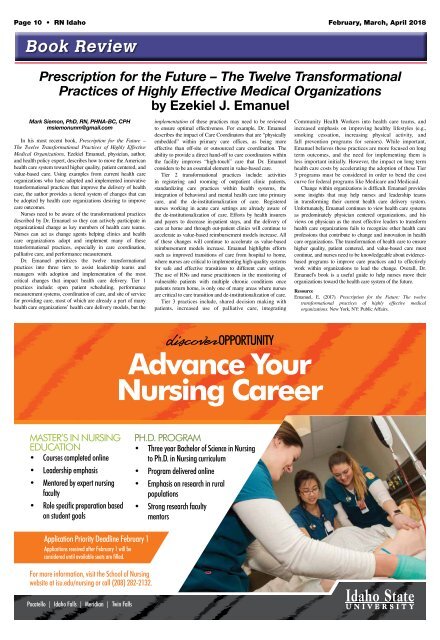RN Idaho - February 2018
Create successful ePaper yourself
Turn your PDF publications into a flip-book with our unique Google optimized e-Paper software.
Page 10 • <strong>RN</strong> <strong>Idaho</strong> <strong>February</strong>, March, April <strong>2018</strong><br />
Book Review<br />
Prescription for the Future – The Twelve Transformational<br />
Practices of Highly Effective Medical Organizations<br />
by Ezekiel J. Emanuel<br />
Mark Siemon, PhD, <strong>RN</strong>, PHNA-BC, CPH<br />
msiemonunm@gmail.com<br />
In his most recent book, Prescription for the Future –<br />
The Twelve Transformational Practices of Highly Effective<br />
Medical Organizations, Ezekiel Emanuel, physician, author,<br />
and health policy expert, describes how to move the American<br />
health care system toward higher quality, patient centered, and<br />
value-based care. Using examples from current health care<br />
organizations who have adopted and implemented innovative<br />
transformational practices that improve the delivery of health<br />
care, the author provides a tiered system of changes that can<br />
be adopted by health care organizations desiring to improve<br />
care outcomes.<br />
Nurses need to be aware of the transformational practices<br />
described by Dr. Emanuel so they can actively participate in<br />
organizational change as key members of health care teams.<br />
Nurses can act as change agents helping clinics and health<br />
care organizations adopt and implement many of these<br />
transformational practices, especially in care coordination,<br />
palliative care, and performance measurement.<br />
Dr. Emanuel prioritizes the twelve transformational<br />
practices into three tiers to assist leadership teams and<br />
managers with adoption and implementation of the most<br />
critical changes that impact health care delivery. Tier 1<br />
practices include: open patient scheduling, performance<br />
measurement systems, coordination of care, and site of service<br />
for providing care, most of which are already a part of many<br />
health care organizations’ health care delivery models, but the<br />
implementation of these practices may need to be reviewed<br />
to ensure optimal effectiveness. For example, Dr. Emanuel<br />
describes the impact of Care Coordinators that are “physically<br />
embedded” within primary care offices, as being more<br />
effective than off-site or outsourced care coordination. The<br />
ability to provide a direct hand-off to care coordinators within<br />
the facility improves “high-touch” care that Dr. Emanuel<br />
considers to be an essential element in value-based care.<br />
Tier 2 transformational practices include: activities<br />
in registering and rooming of outpatient clinic patients,<br />
standardizing care practices within health systems, the<br />
integration of behavioral and mental health care into primary<br />
care, and the de-institutionalization of care. Registered<br />
nurses working in acute care settings are already aware of<br />
the de-institutionalization of care. Efforts by health insurers<br />
and payers to decrease in-patient stays, and the delivery of<br />
care at home and through out-patient clinics will continue to<br />
accelerate as value-based reimbursement models increase. All<br />
of these changes will continue to accelerate as value-based<br />
reimbursement models increase. Emanuel highlights efforts<br />
such as improved transitions of care from hospital to home,<br />
where nurses are critical to implementing high-quality systems<br />
for safe and effective transitions to different care settings.<br />
The use of <strong>RN</strong>s and nurse practitioners in the monitoring of<br />
vulnerable patients with multiple chronic conditions once<br />
patients return home, is only one of many areas where nurses<br />
are critical to care transition and de-institutionalization of care.<br />
Tier 3 practices include, shared decision making with<br />
patients, increased use of palliative care, integrating<br />
Community Health Workers into health care teams, and<br />
increased emphasis on improving healthy lifestyles (e.g.,<br />
smoking cessation, increasing physical activity, and<br />
fall prevention programs for seniors). While important,<br />
Emanuel believes these practices are more focused on long<br />
term outcomes, and the need for implementing them is<br />
less important initially. However, the impact on long term<br />
health care costs by accelerating the adoption of these Tier<br />
3 programs must be considered in order to bend the cost<br />
curve for federal programs like Medicare and Medicaid.<br />
Change within organizations is difficult. Emanuel provides<br />
some insights that may help nurses and leadership teams<br />
in transforming their current health care delivery system.<br />
Unfortunately, Emanuel continues to view health care systems<br />
as predominately physician centered organizations, and his<br />
views on physician as the most effective leaders to transform<br />
health care organizations fails to recognize other health care<br />
professions that contribute to change and innovation in health<br />
care organizations. The transformation of health care to ensure<br />
higher quality, patient centered, and value-based care must<br />
continue, and nurses need to be knowledgeable about evidencebased<br />
programs to improve care practices and to effectively<br />
work within organizations to lead the change. Overall, Dr.<br />
Emanuel’s book is a useful guide to help nurses move their<br />
organizations toward the health care system of the future.<br />
Resource<br />
Emanuel, E. (2017). Prescription for the Future: The twelve<br />
transformational practices of highly effective medical<br />
organizations. New York, NY: Public Affairs.

















